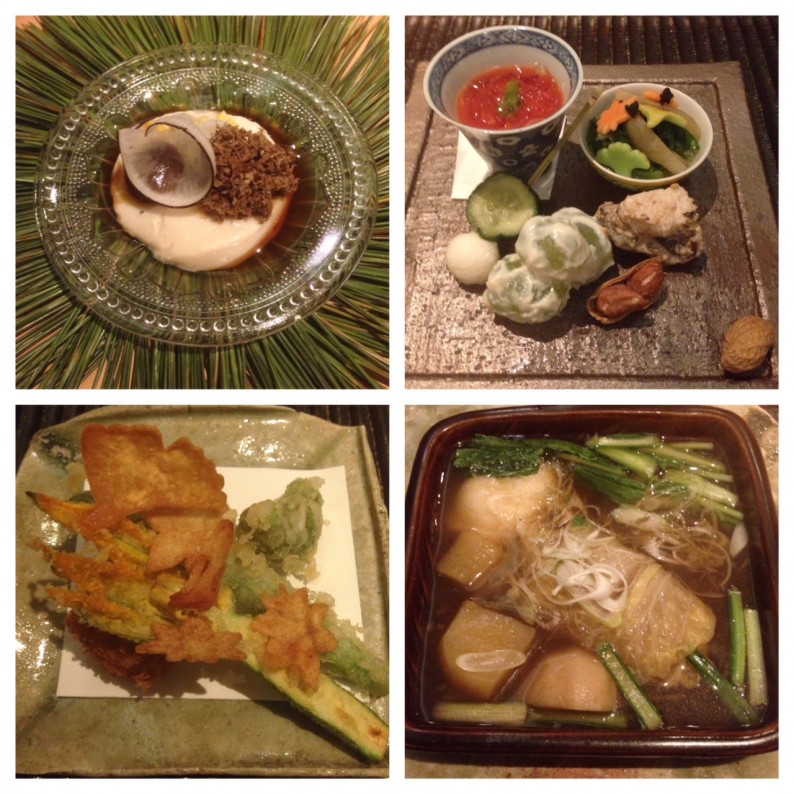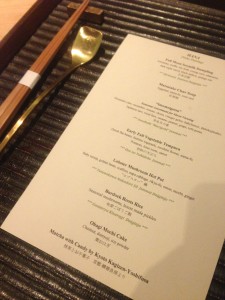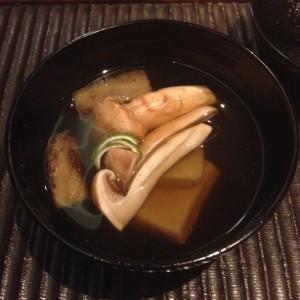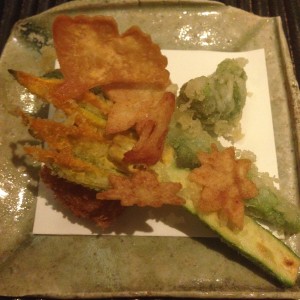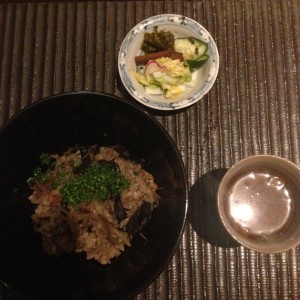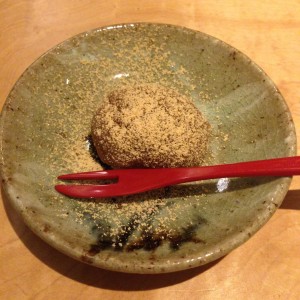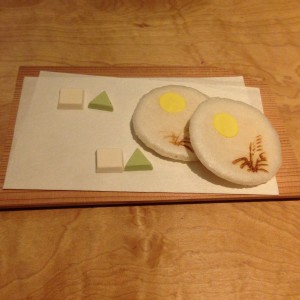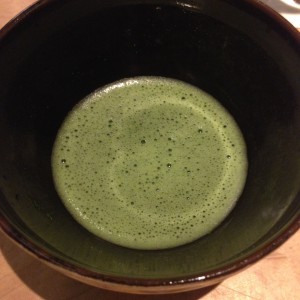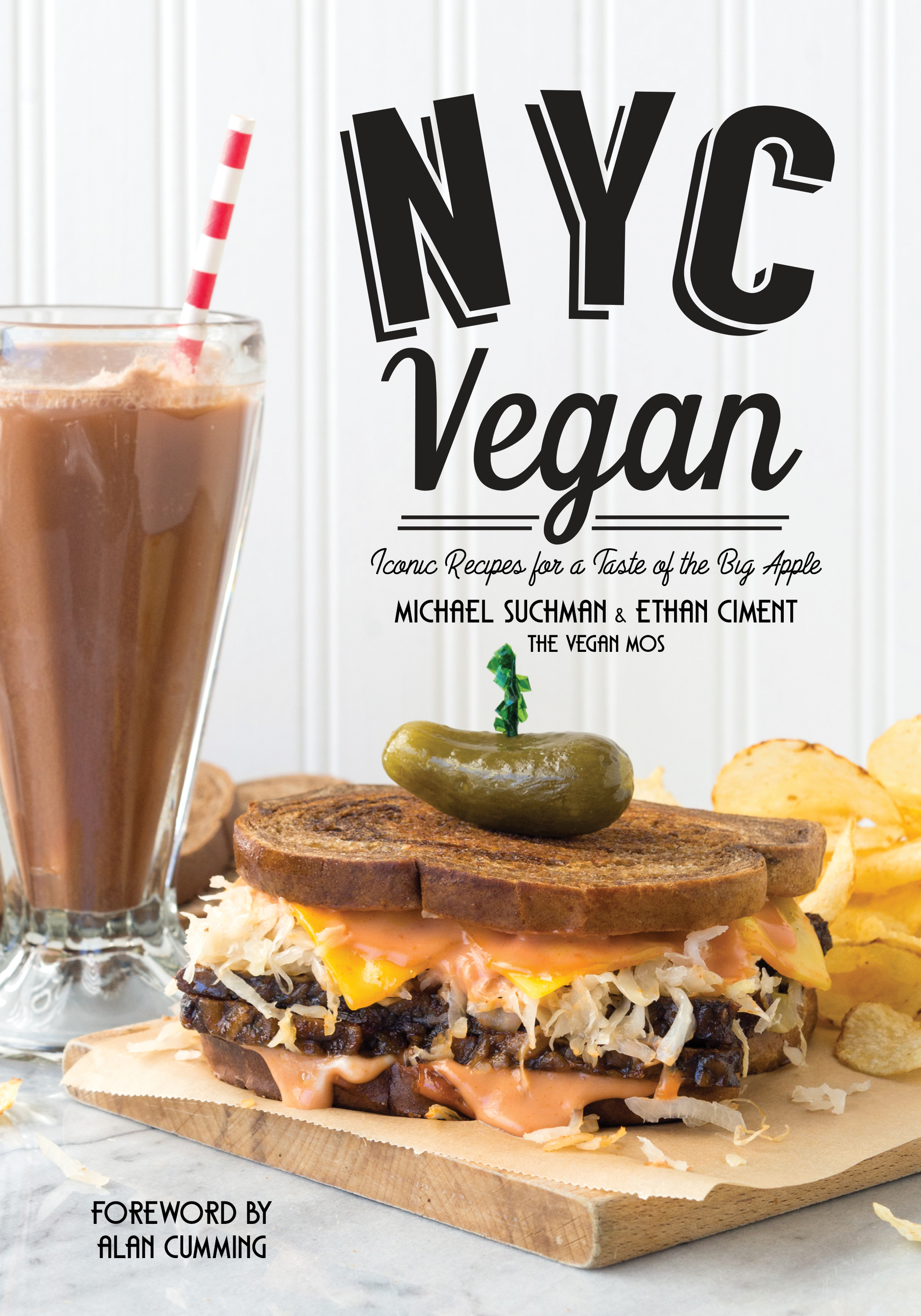To celebrate my 3 year veganniversary, Ethan took me to dinner at Kajitsu. Kajitsu means “fine day”, or “day of celebration” in Japanese. The owners chose the name Kajitsu hoping that a visit here will always be a special occasion for their guests. Dining here is about more than having a great meal, it is an experience. Kajitsu is not your run of the mill Japanese restaurant; it serves shojin cuisine. As stated on its webpage:
Shojin cuisine refers to a type of vegetarian cooking that originates in Zen Buddhism. Even though it does not use meat or fish, shojin is regarded as the foundation of all Japanese cuisine, especially kaiseki, the Japanese version of haute cuisine. In its present form kaiseki is a multi-course meal in which fresh, seasonal ingredients are prepared in ways that enhance the flavor of each component, with the finished dishes beautifully arranged on plates. All of these characteristics come from shojin cuisine, which is still prepared in Buddhist temples throughout Japan.
The restuarant itself is very sparsely decorated: the walls are a muted soft and warm cream color with no adornments, the tables are slabs of wood that have been sanded, stained and given a high polish. There is no ambient music and the lights are slightly dimmed. The goal is to have your focus be on the food and the experience of dining here. And, it works. As each course was served, I was taken by the elegance of the presentation. Each course is equisitely presented like a work of art. The presentation is as much a part of the meal as the food. As each course is presented, for they are presented, not served, the presenters explain the components of each dish and when necessary, give instruction on how to eat it. Unlike in most restaurants, when ordering your meal at Kajitsu you have only to choose from the 4 course “Kaze” or the 8 course “Hana.” The menu changes monthly to reflect the season and what is freshest at the time. If you choose the Hana meal, you do get to select whether you want Burdock Roots Rice or Cold Udon Noodles for your 7th course, the rice is standard with the Kaze. As this was a celebration, Ethan and I went with the Hana and Burdock Roots Rice. We also added a half sake pairing which gave us each 5 1-ounce glasses of sake, served through the meal. Each sake is selected to accompany a specific course. After we ordered, we were presented with small, printed menus specifically showing our meal and sake pairings, like a program for the meal.
The first course was the Full Moon Soymilk Dumpling with artichoke, truffle, lily bulb, young corn, edamame, dark night carrot, black daikon, and ginko nut. The dumpling was not a gyoza as one would expect in Japanese restaurant. Instead, it was like a firm tofu custard that was soft and creamy. The artichoke, lily bulb, corn, edamame, carrot and ginko nut were diced and hidden under the dumpling. On top the dumpling was a generous serving of shaved truffle and a curl of black daikon. The entire dish was surrounded with a light soy-based sauce. It was a delicate balance of flavors and textures that created a wonderful start to what was clearly going to be an amazing meal.
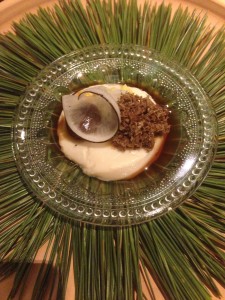
Full Moon Soymilk Dumpling with artichoke, truffle, lily bulb, young corn, edamame, dark night carrot, black daikon and ginko nut.
The second course was Matsutake Clear Soup. This light broth was filled with eggplant, yuzu zest and nama-fu. Nama-fu is a Japanese version of seitan in which wheat gluten is combined with glutinous rice flour and millet and then steamed. The result is a soft block that can be shaped or colored in a variety of ways. It is much softer and lighter than its American counter part, seitan. Our server told us that the owner of Kajitsu has his nama-fu imported from a specific maker in Japan. The warm broth was delicately seasoned and balanced the richness of the eggplant.
We then moved on to the “Imomeigetsu,” a seasonal assortment for Moon Viewing. The chef designed this month’s menu at Kajitsu to celebrate the full moon and the components of this course reflect the care he took in planning it. This course had several parts to it and we were instructed on the proper order in which to eat from the plate. We started with the tomato, okura and vineger gelee. This gelee was in a small cup for sipping. The sweetness of the tomatoes was a nice way to wake up the tastebuds after the mild soup we had just eaten. This was then countered with dish of babyleaves and daitokujinatto, and colored nama-fu that was cut into the shapes of leaves and stars. We then moved on to the pureed taro root with sesame and royal fern. The richness and earthiness of the taro balanced the soft delicate flavors of the babyleaves and daitokujinatto. Next came the peanuts that were lightly roasted in a tamari sauce. The crunch and slightly salty tasted were a perfect counter to the soft taro. Next were grapes covered in a tofu puree. I admit, the description did not thrill me, but the execution was great. Sweet, firm green grapes covered in a creamy tofu puree are wonderful. Again there is a nice balance of textures (soft and silky matched with crisp and firm) and tastes (mild tofu and sweet grapes). The last component of this couse was a piece of mountain yam and a slice of cucumber, both of which were crisp and flavorful. Side note, as I am allergic to peanuts, the chef was able to swap out the peanuts on mine for a piece of pickled vegetable to aproximate the texture and seasoning of the peanuts (I didn’t understand what our server said it was, but it was delicious).
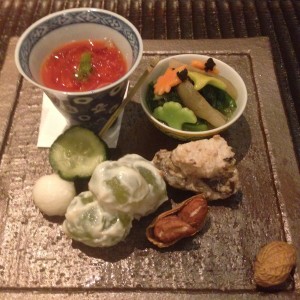
“Imomeigetsu” Seasonal Assortment for Moon Viewing: (clockwise from top left) tomato, okura, vinegar gelee; baby leaves, daitokujinatto; Japanese taro, royam fern, sesame; peanut; grapes with tofu puree; mountain yam and cucumber.
The next course was Early Fall Vegetable Tempura. The plate of lightly battered vegetables included Dutch flat beans, fushimi togarashai (a Japanese chili pepper – which I wish I knew what it was before biting into it) zucchini flower, nama-fu, potatoes, lotus root and carrot. The vegetables were neither heavily coated not greasy. This was possibly the best tempura I have ever had. While I loved it all, the best for me was the fried zucchini flower. In fact, I advised Ethan to save it for last. The tempura is served with a wedge of lemon and a small pile of salt. Our server explained that the lemon was to squeeze over the vegetable and then we should either dip the vegetables into the salt or sprinkle it over them before eating.
The tempura was followed by a Lobster Mushroom Hot Pot. This large palte was filled with baby turnip, golden beets, scallion, mochi, ginger and a large leaf of napa cabbage filled with onion and kikyu-fu, all swimming in a rich and hearty lobster mushroom broth. Our server told us there was no specific order in which to eat the components of this dish, so just dug in. The broth was amazing. It had a taste of ginger and an amazing depth of flavor from the mushrooms. If you are familiar with umami, this broth is a prime example of it. The cabbage roll was packed with diced rikyu-fu, another version of Japanese wheat gluten that is firmer than nama-fu, and onions, so as soon as you cut it open, the fillings poured into the broth, just adding even more flavor. The mochi was dense and chewy which balances the slight firmenss of the turnip and beets. This dish was the standout of the entire meal. It was as if each previous course was building up to this moment.
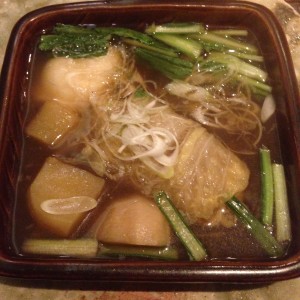
Lobster Mushroom Hot Pot with baby turnip, golden beets, scallion, napa cabbage, rikyu-fum onion, mochi and ginger.
Now that our tastebuds were in hypermode from the amazing hot pot, we were served our 6th course, the last of the main meal before dessert, the Burdock Roots Rice we chose at the start of our dining adventure. The rice was nicely sticky, so eating with chopsticks was easy. It was filled with diced mushrooms and burdock root. The softness of this course allowed us to gently float back down to earth after the flavor explosion of the hot pot. Along with the rice was a small dish of housemade pickles and a cup of miso soup. Again, no order for eating was provided so we just jumped between all three. The rice was rich and earthy, the pickles, crisp and slightly tart and the soup, warm and soothing.
After 6 courses, we were now ready for dessert. The first of our two dessert courses was an Ohagi Mochi Cake. Inside the cake was a piece of chestnut and it was dusted with soy powder. The chewiness of the mochi cake was offset by the crunchiness of the chestnut.
As our last couse came, I was a little sad, as we were now at the end of this experience. We ened our meal with Matcha with candy by Kyoto Kagizen-Yoshifusa. The plate contained a slightly sweet rice cracker and two pieces of sugar candy. The desserts were not overly sweet and provided a gentle finish to the meal. Along with these came a small bowl of Matcha to wash everything down.
Kajitsu is not your everyday Japanese restuarant and you don’t come here to simply eat. You come here for a dining experience. But make a reservation and allow plenty of time for your meal. Our 8 course experience took over 2 hours. Time very well spent.
Kajitsu
125 E 39th Street
New York, NY 10016
212-228-4873

